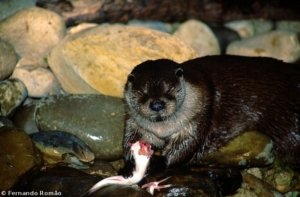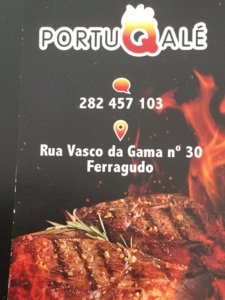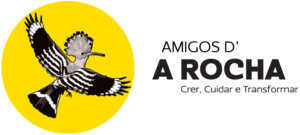
Newsletter January 2020
Welcome to our January Newsletter 2020 
It’s a New Year and we have new Monthly Articles and New Contributors!
We hope you enjoy the changes.
Happy New Year! We hope it brings you Peace, Love and Happiness!
Thank you for being ‘A Friend’.
Helen & Filipa
S
N
A
P
SHOT

João Paulo Soares Carraco

Nationality: Portuguese
Age: 48 years
Proprietor of the Chicken Tavern Restaurant, Alvor
I was born in Marinha Grande in central Portugal, where I attended school and studied until 12th Grade. I travelled and worked in Switzerland and England .
Returning to Portugal, I worked with my father who was a Blacksmith, I trained with him and we produced handmade tools, and forged iron for gates and railings. I married and had a family, and went into business on my own, opening two carpet shops in Nazare.
I moved to the Algarve in 2001 after my divorce and started a business selling tools and knives in the local markets both in the East & West of the area, from Castro Marim to Sagres.
In 2015 I opened the Chicken Tavern Restaurant with a partner who was in the Catering Trade, I then took over on my own. I had run several businesses, which gave me the experience to run the Chicken Tavern. I started with 3 employees and now I employ 9 people as the business has grown and become more successful.
In July 2019 I went into partnership and we opened a Restaurant in Ferragudo which has a slightly different menu and is called Portuqale ( an old way of spelling Portugal).
I enjoy living in Alvor, I have 2 children who attend school here and I feel part of the community.
IFO’s – Identified Flying Objects…
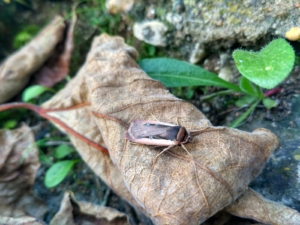
Radford’s flame shoulder
(Ochropleura leucogaster, Freyer, 1831)

Morphology: It is a moth from the Noctuidae Family; with a wingspan between 32 and 36 mm; the forewing has brown ground colour with a contrasting pale costa and black streak; the hindwings are white. When it rests the wings are close to the body, giving it an elongated shape. Produces two generations per year. Adults fly from November to January.
Habitat: Inhabits wet and humid places, with dense low vegetation.
Distribution: Afro-tropical and subtropical distribution, occurs from Madagascar across Africa and Madeira to the Mediterranean Region and the Arabian Peninsula.
Notes: The larvae is polyphagous and eats many types of herbs. It is very similar to Ochropleura plecta, this is more reddish and bright in colour, smaller and has a wider distribution (all the Northern hemisphere).
Tweet… Tweet…

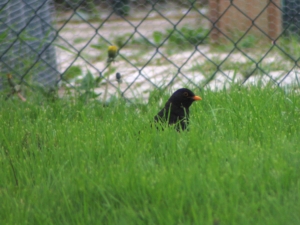
Eurasian Blackbird
(Turdus merula, Linnaeus, 1758)
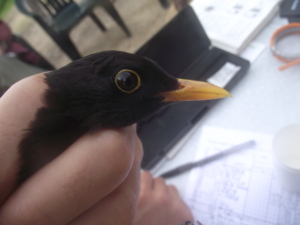
Identification: It is a passerine from the Turdidae family with a wingspan between 32 and 38 cm. The males are all black with a bright orange bill and orange eye ring; females are dark brown, sometimes with paler feathers on the breast, the bill is darker. It has a very melodious song and a very load alarm call. Can lay two to three broods per season.
Habitat and Ecology: Wide variety of habitats, forests, urban areas, gardens, parks and town shrubberies, also in farmlands; often associated with human presence. The specie is mainly resident, but in some northern areas can be migratory. In Portugal it is a resident species. It is omnivorous, feeding on insects, worms, fruits and berries.
Distribution: Europe, Asia and North Africa. Has been introduced in Australia and New Zealand.
Threats: Least Concern in the International Union for Conservation of Nature (IUCN) red list. Several geographic subspecies are recognized. In Portugal the nominal species exists Turdus merula sp merula (the same as in most part of Europe). The oldest blackbird ringed was 20 years and 3 months!
DID YOU KNOW?
- A Rocha started officially as a Portuguese Association in 1991, but before that, work was already happening! Part of A Rochas work was and is still done by volunteers. See the video by Isabel Soares:
Eurasian Otter (Lutra lutra, Linnaeus, 1758)
Family: Mustelidae
Distribution: From west coast of Ireland and Portugal to Japan, form Artic Finland to Indonesia and sub-Saharan regions of Africa (see map).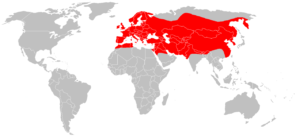
The otter is a carnivorous mammal, it has a long and slim body, short legs, long tail, wide muzzle, small eyes and short ears. The hair is dark brown, long, soft and shiny and it is well adapted to the aquatic life (the otter has the same weight, dry or wet and this is related to the effective protection of the double hair layer). The otter can occupy all the continental aquatic habitats (lakes, rivers, streams, marshlands, water channels) that are well preserved and with little human interference, as well as estuaries and marine habitats. Important requirements in habitat selection are the presence of suitable vegetation to provide shelter, availability of food and human disturbance. Their diet is mainly fish but can also feed on arthropods, reptiles, micromammals and birds.
Reproduction can occur all year round; the otter females, as other members of the Mustelidae Family, have the capacity of keeping the fecundated ovules attached to the uterus walls and their development just happens afterwards, so pups can be born when the environmental conditions are more suitable, normally in Spring or Summer. The otters are mainly solitary animals and males need large vital territories.
In Portugal the otter population is regularly distributed among the territory and the numbers are stable comparing with other European countries, where the population was dropping in the last years, and it was even considered extinct in some countries. According to the IUCN (International Union for the Conservation of Nature) red list, globally, it is considered NT (Near Threatened), in Portugal it is Least Concern. The major threats are habitat destruction, water pollution, water system regularization, accidental killing by running over, drowning by fishing methods and direct persecution.
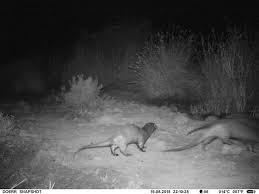
Eurasian Otter at Ria de Alvor 2015
POPPED UP

Identification: It is an evergreen shrub or small tree from the Adoxaceae Family; it is rounded and compact up to 3 metres in height, with reddish bark in young branches. The leaves are long with a short leaf stalk, leathery, simple, and oval with glossy dark green colour in upper parts and paler at the lower. It has a flat terminal inflorescence with small whitish hermaphrodite flowers united in compound corymbs. The fruit is an ovoid drupe, metallic blackish blue in colour, continuing in the plant for about one year. Flowers from January to April. Fruits in summer and beginning of autumn.
Habitat and distribution: Perennial woodlands and along river banks. It occurs in all of the Mediterranean basin. In Portugal it is present mainly in the south and centre of the country.
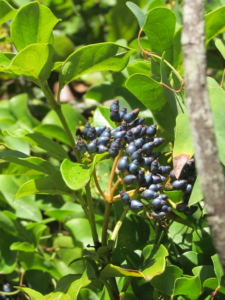
Laurustinus (Viburnum tinus, Linnaeus, 1753)
Notes: it reacts well to pruning, growing even from the old branches. It is widely used as an ornamental plant for hedgerows, both in sun and shadowy places. Almost all parts of the plant contain toxic substances. It is one of the ornamental bushes mostly cultivated in Portugal. In old times it was used for constipation.
DATES TO REMEMBER

1st of January – New Years Day/Public Holiday
2nd, 9th, 16t, 23rd and 30th of January Cruzinha Birdringing display & Moth Talk (10am to 12 am)
6th of January Kings Day (Twelfth Night, down come the decorations)
Thank you for supporting the Friends of A Rocha Portugal

Dr Roy Rodrigues
Av. Do Brasil, Qta das Palmeiras, Lt P2, R/c A, 8500-299 Portimão
(+351) 282180683
royaldente@gmail.com

Sítio da Amoreira, Lote 12,
Alvor, 8500-045 Portimão
(+351) 282412562/ 925433047
www.transfair.com.pt
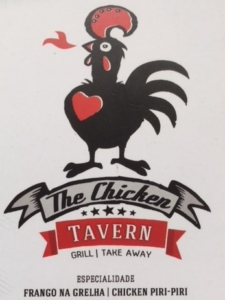
Estrada principal Quatro Estradas de Alvor, nº 30
8500 – 045 Portimão
(+351) 911597735
Closed on Thursdays
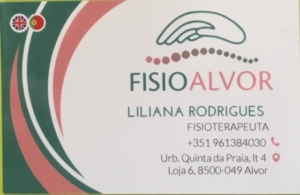
Physiotherapy, Massages (relaxation, sports, therapeutic)
Other therapies
Beauty (manicure, pedicure, hair removal, facials)
Open Monday to Friday
Thought of the month 
“Be the change that you wish to see in the world.”
― Mahatma Gandhi (1869 – 1948 Indian Lawyer, anticolonialist and social activist)

LETS BE GREEN – LETS BE GREEN – LETS BE GREEN 
Every month we will share information that can change the world. Sometimes small things can make a big difference. The world is our planet and our home, we all need to take care of it!
As an environmental organization and as citizens of the world, in a time which we constantly hear about climate change, one of our concerns is Environmental Conservation. We try to promote sustainable values and change attitudes and behaviour concerning the environment.
In Portugal each individual produces on average 487 kg of rubbish per year!
By following the 5 R’s maybe we can all make a difference?
Do you know what the 5 R’s are ?
1 Rethink: think about your choices, there are simple and eco-friendly actions (have you considered an in home composter for your organic waste? Or repairing your computer instead of buying a new one?)
2 Refuse: say no to plastic disposable things that have short life duration (refuse the straws-do you really need a straw in your drink? refuse plastic shopping bags – use reusable shopping bags)
3 Reduce: try to reduce the amount of waste you produce (avoid buying things with useless plastic packaging)
4 Re-use: think of ways you could reuse something (find a reusable water bottle and reused shopping bags, reuse the glass containers)
5 Recycle: (and composting) this enables materials you throw away to be used again by making them into new products
LETS BE GREEN – LETS BE GREEN – LETS BE GREEN
Friends Event – A trip with Gui Rethore to Quinta da Lago on 3rd December 2019 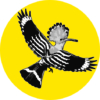
Our last Friends Event of the year and what an amazing day, it was sunny with blue skies and perfect for birdwatching.
The group set off in a convoy of three vehicles and drove to Quinta Da Lago, hoping for a day of bird sightings, and wonderful scenery. It couldn’t have been any better, there were between 55 – 60 species sighted. The Swamp Hen was a favourite, the once shy birds are obviously getting used to humans who are playing golf in the area and seem to pay no attention to their presence. This enabled everyone to see this colourful bird out in the open, they normally hide in the reeds.
A decision was made due to the abundance of birds for a slight change of plan and there was less walking and more birdwatching. Everyone had nothing but praise for Gui, his knowledge and passion shone through. THANK YOU GUI for making this another amazing day.
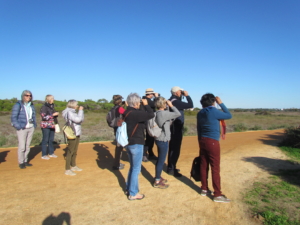
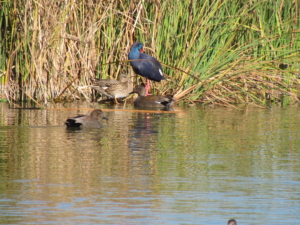

Unravelling the success of the Iberian azure-winged magpie: Success with a consequence? – Continued!
Allow me to reintroduce myself: My name is Tessa, I’m 24 years old and I’m a Master student from the Wageningen University in the Netherlands, where I study Forest and Nature Conservation. You may remember my article from the June’s Newsletter, where I wrote about the Iberian azure-winged magpie (Cyanopica cooki). At the time my research was still ongoing, and I was out in the field almost everyday to look for these beautiful birds. Now, almost half a year later, my written thesis has been completed and I believe to have unravelled the success of the Azure-winged Magpie! But before I tell you about all my findings, here is a short recap:
 The Iberian azure-winged magpie has been found to have increased in numbers in southern Portugal in the past decades, but it is unknown what makes this species so successful. Considering that many bird species are currently declining, it is interesting to know what can make a species successful in our current time and age. Moreover, it is rumoured that the magpies steal and eat the chicks of other passerine birds. This means that the success of the Iberian azure-winged magpie could become a double-edged sword that threatens the existence of other birds, and thus, research is needed! In order to unravel the factors behind its success and to further study these rumours, I did a fieldwork study together with Esra (18), another student from the Netherlands. Together we cycled line transects in the field. I also did a small behavioural study on the azure-winged magpie in the area near Cruzinha. During the line transects we specifically looked at the urban : green ratio within each section of the line transect, but we also recorded a handful of other variables. The reason we looked at the urban : green ratio is that, in the first weeks of fieldwork, Esra and I went to all kinds of natural areas, located far up in the hills, in the forests or in the middle of nowhere, yet we barely encountered any magpies no matter where we went. However, whenever we made our way back home and would cross towns, suddenly we’d see magpies everywhere! This gave me an idea… perhaps the magpies aren’t out there in the wild anymore, but there where the people are?
The Iberian azure-winged magpie has been found to have increased in numbers in southern Portugal in the past decades, but it is unknown what makes this species so successful. Considering that many bird species are currently declining, it is interesting to know what can make a species successful in our current time and age. Moreover, it is rumoured that the magpies steal and eat the chicks of other passerine birds. This means that the success of the Iberian azure-winged magpie could become a double-edged sword that threatens the existence of other birds, and thus, research is needed! In order to unravel the factors behind its success and to further study these rumours, I did a fieldwork study together with Esra (18), another student from the Netherlands. Together we cycled line transects in the field. I also did a small behavioural study on the azure-winged magpie in the area near Cruzinha. During the line transects we specifically looked at the urban : green ratio within each section of the line transect, but we also recorded a handful of other variables. The reason we looked at the urban : green ratio is that, in the first weeks of fieldwork, Esra and I went to all kinds of natural areas, located far up in the hills, in the forests or in the middle of nowhere, yet we barely encountered any magpies no matter where we went. However, whenever we made our way back home and would cross towns, suddenly we’d see magpies everywhere! This gave me an idea… perhaps the magpies aren’t out there in the wild anymore, but there where the people are?
Now that you’re all up to date, let’s get to what we found! First of all, we found that Iberian azure-winged magpies highly prefer areas that have an intermediate to high (50% – 75%) cover of green area, which we named Category 3 and 4, respectively. Here, the remaining area is considered urban, which includes households, buildings and hardened terrain. These areas contained significantly more magpies than areas with a low green area cover (Category 1; 0% green and Category 2; 25% green), but also significantly more than areas that are completely green (Category 5; 100% green)! This is quite surprising, as it has not yet been mentioned in literature that Iberian azure-winged magpies now occur rather close to human settlements. As seen in these results, the magpies prefer areas with a mix of nature and human settlements over areas that are completely green or completely urbanized. This is precisely what I expected after the observations made in the early fieldwork stage, and changing my method seems to have been a good call after all!
During the behavioural study it also became clear that magpies tend to flock to human settlements in order to look for food, be it our own food or the feed of the animals. I regularly observed magpies stealing the food from the dogs at Cruzinha, and I also received footage of magpies stealing food from cats, dogs and even geese. Another behaviour I observed regularly was that of magpies flying into a garden and, after a few minutes, flying back to a natural area where they’d clean their beaks. After this, they would often return to the garden again, from where they repeated the cycle. It is likely that the magpies were foraging in the gardens and returned to a safe natural area after feeding to clean their beaks. Moreover, I observed many magpies using fences, poles and powerlines as a look-out post from which they could search for food. In this manner, they can use infrastructure to improve their foraging strategies. These observations show that the magpies have learned how to take advantage from human settlements while also still enjoying the safety and resources of natural areas. This would also explain why the magpies nowadays prefer areas with low to intermediate levels of urbanization. Looking at other species from the Corvidae family shows that many species of magpies, crows and raven have learned how to use human settlements to their advantage, and some species even have higher reproduction rates when breeding near human settlements. It is likely that the Iberian azure-winged magpie is one of the latest species in the Corvidae family to have learned how to profit from humans.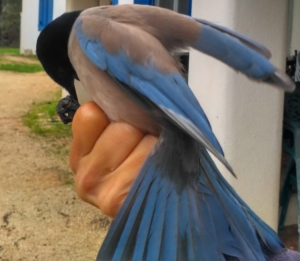
Now one question remains, which is whether the Iberian azure-winged magpie predates on the eggs and chicks of other passerine birds. I did not observe this behaviour during my stay, however this does not necessarily mean that the magpies do not predate on other birds. It likely has to do with my behavioural study being too small (about 20 hours of observations) to observe this possibly scarce behaviour. Moreover, I may also have conducted the study too early in the season (end of March – beginning of May), when there was not yet an abundance of eggs and chicks for the magpies to steal. As such, further research may be needed to discover whether the magpies do indeed regularly predate on eggs and chicks and, if so, what the impact of this behaviour is on the populations of bird species that are predated on by the magpies.
Overall, I conclude that the Iberian azure-winged magpie has learned to profit from human settlements, which improved its foraging strategy and has likely aided to an increased reproductive success. As such, the magpie population has been able to successfully expand over the past decades. However, it is still unknown whether the species predates on the eggs and chicks of other passerine birds, and how large the impact of this behaviour would be. As it is likely that the Iberian azure-winged magpie population will continue to increase, some might be happy knowing that this colourful magpie species will continue to roam the skies of southern-Portugal, while others might fear for their pets’ dinner. I, for one, look forward to seeing these beautiful, cheeky birds again one day!
Let’s get cooking ! 
We are really pleased to announce that we have an Executive Chef who works in the Algarve who has kindly offered to contribute one of his recipes each month to our Newsletter. We hope you all enjoy this new addition for 2020.
Marmalade with Pennyroyal and Medronho
Ingredients:
2 kg ripe and clean quince
200 gr ripe and clean medronho
750 gr sugar
Peel of 1 Orange
50gr Pennyroyal
2 Cinnamon sticks
100ml Medronho (strawberry tree firewater)
Peel and clean the quince, boil for about 3 minutes. Drain well.
In a pan put the sugar, the pennyroyal, the cinnamon sticks, the orange peel and 1 litre of water. Boil slowly for 10 minutes. Take out the pennyroyal, the cinnamon sticks and the Orange peel.
In a large pan put the cooked quince and the dry “medronho”, add the sugar syrup.
Cook on a low heat for 1 hour stirring often (ensuring there are no lumps) until it thickens to a smooth consistency.
Put in containers, sprinkle with medronho and cover with greaseproof paper. Leave it to dry in a cold and ventilated place for about 3 days.
It is ready to eat!!

Alarming picture
SPEA recently published the State of Birds in Portugal 2019 report; the first compilation of data from most of the country’s bird monitoring programmes. The report reveals alarming results that require immediate response. The report comprises data obtained thanks to hundreds of volunteers throughout the country over the past 15 years. In spite of the worrying picture it paints of the nation’s birds, the report has one positive note: nature conservation works.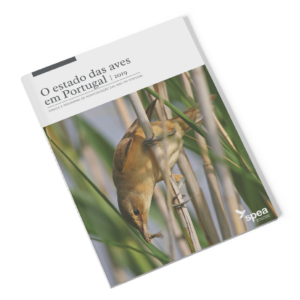
More info (in Portuguese): http://www.spea.pt/pt/noticias/relatorio-revela-panorama-preocupante-para-as-aves-portuguesas/
Download the report: bit.ly/EstadoAves

Check the website for dates for organised tours
Bonelli’s Eagle
The Bonelli’s Eagle is a species of bird of prey which is found in the Western Palearctic and is mostly in Southern Europe and North Africa. Iberia hosts 80% of the European population. In Portugal, the population was estimated between 92 and 99 pairs during the period 1999-2005, mostly in the East and South of the country, with about 30 pairs in the Algarve and south-west of the Alentejo. In Portugal, the population is growing but differences exist between regions. A cause of reduction in numbers is the increase in forest resulting in a decrease in hunting territories. Also the decrease of rabbits had an impact on the population of eagles since there is a correlation between the proportion of rabbits in the Bonelli’s Eagle diet and the breeding success. The other preys include pigeons (sometimes in a big proportion when the eagles breed near a town), partridges (but few, even though its Portuguese and Spanish name is the “Partridgy Eagle”) or Ocellated Lizard. In southern Portugal the Grey Heron is one of the biggest preys this eagle catches. Its diet even includes other birds of prey (diurnal or nocturnal)! The pair, which usually bonds for life, hunts as a couple. 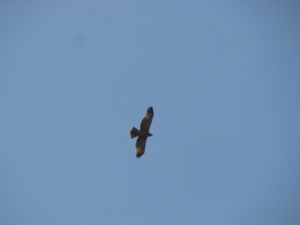
The nest is usually on a cliff but population from the south of Portugal breed on big trees (mostly eucalyptus, sometimes pine trees or Cork oaks). This difference of where they nest is one of the reasons the population in southern Portugal is increasing. One or 2 eggs are laid in January or February. The adults are resident but the juveniles wander a lot after leaving the parent territory. Some of them travel several hundreds of kilometers.
At Ria de Alvor, this species was sighted 5 times since 1986 even though the closest pairs are just a few kilometers away! Three of these sightings were in the autumn (between September and November) are all related to juveniles or immature birds, which matches with dispersion time of the young birds.
This species is tolerant to human presence as long as they are not disturbed during the breeding period.
The name Bonelli comes from an Italian naturalist from the XIXth century. Temminck (another naturalist, which a Stint was named after) proposed that the eagle was named after the Italian naturalist since he was the first one to send him a specimen of the species to study. This species is also the symbol of the Portimão football team!
Photo and text by Guillaume Réthoré

Exotic Trees (Part 1)
by Roger McIlroy
An “exotic tree” is an introduced tree i.e. it is a non-native species usually brought to the Algarve by human activity, either deliberate or accidental. Exotic species can have an unpredictable effect on the local ecosystem. Some have a negative effect on a local ecosystem, out-competing local species, and becoming dominant, often because they have few local predators. Other introduced species may have no negative effect or only minor impact and could be considered to have added to biodiversity.
Exotic trees have generally been introduced for their economic benefits or for their decorative effect, whether form, flowers, seeds or bark.
This is the first part of a series on exotic trees that can be seen in the vicinity of the author’s home in Algar Seco, Carvoeiro, and discusses an exotic tree that originates from Oman and Yemen in the Middle East, the truly exotic Carob.
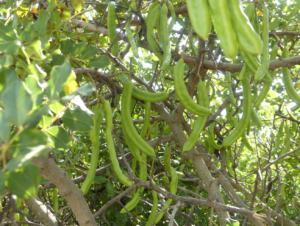
Figure 2: Green immature Carob pods (Tivoli Hotel, Carvoeiro (RM))
The mature pods are quite hard and woody and can be chewed straight off the tree as a tasty snack as the ancient Egyptians did, spitting out the hard seeds. This feature makes its means of propagation clear, i.e. browsing animals eat the pods and the undigested seeds come out the far end in nice lumps of ready-made compost to allow the seeds a good start in life!
If the pod is broken apart the hard, brown seeds of some 7mm diameter can be extracted. Carob powder comes from the crushed pod, while the seeds produce “locust bean gum” used in cosmetics, almond milk and ice cream.

Figure 4: Carob seeds extracted from broken pods by the author (RM)

Figure 5: Carob chocolate from Cyprus.
Another interesting fact is that the unit “carat”, used for weighing precious metal and stones, comes from the word carob, as In Roman times, the gold coin, the “solidus” weighed 24 carat seeds (about 4.5 grams), and today, 24 carat gold means 100% gold, and for diamonds one carat is essentially the weight of one carob seed and fixed at 0.2 gram.
The Carob Ceratonia siliqua
(Portuguese- Alfarrobeira)
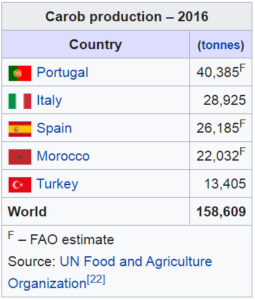
Although the Carob is a common tree in the Algarve, it is not an indigenous tree, but in fact has been cultivated in the Middle East for over 4,000 years! However, today, Portugal cultivates more than anywhere else!
It is a very distinctive tree due to the large numbers of carob pods that hang from the branches and even from the trunk. These are initially green but turn to black when mature and eventually fall onto the ground where they can be collected or eaten by mammals.
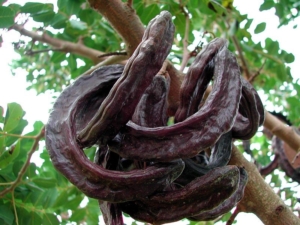
Figure 3: Black mature Carob pods
Cyprus was the centre of the ancient carob industry and their widespread cultivation was often commented on by ancient travellers with carobs exported in vast quantities. The workers who built the pyramids probably had a pod or two in their lunch boxes! The Egyptians also crushed the pods to produce a popular drink, so popular that the Pharaohs sent representatives to Cyprus to collect only the best carob pods to be sent to Egypt. They also extracted a gum from the seeds (LBG- Locust Bean Gum) to produce a liquid which they used in mummification.
Carobs also have the rather strange name of “St. John’s bread”. This misnomer seems to have come about as the Bible (Mathew 3:4) refers to St. John the Baptist eating locusts and honey to sustain himself while travelling in the wilderness. Devout Christians believed that it would be unbecoming for a saint to be eating insects and so gave the alternative explanation that St John must have been eating carob pods, and so carobs became known as St John’s bread!
The carobs were spread by the Greeks to the western Mediterranean, and then brought by the Moors during their invasion of Iberia.
If you wash a pod, and have a nibble, the chocolatey taste is very obvious, and indeed it is widely used as a chocolate substitute! Nutritionally it is also much better for you than chocolate, containing less sucrose, almost no fat but also contains 8% protein, double the fibre, vitamins A and B plus several minerals. It contains only one-third the calories of chocolate, no caffeine or any other addictive substances, and so makes an ideal substitute for chocolate.
The flowers are quite distinctive, and often can be found sprouting from the trunk! It is sometimes “dioecious” i.e. some trees are male and some are female, but some are hermaphroditic, that is, it has both male and female flowers. The local tree photographed here is hermaphroditic in that it has both initially red male flowers with prominent stamens and also female flowers with their embryo pods. Some flowers have even both male stamens and female pods! The male flowers are however rather smelly, described by Roman historian, Pliny the Elder as smelling like Roman sailors!

Figure 6: Immature male flower (Algar Seco, RM)
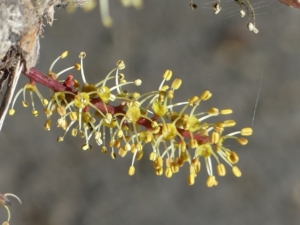
Figure 7: mature male flower with prominent stamens (Algar Seco, RM)
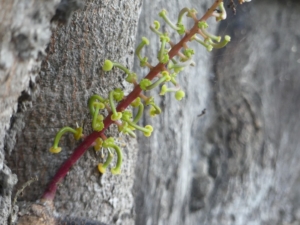
Figure 8: mature female flower with embryo carob pods (Algar Seco, RM)
What an interesting tree! Look out for it and enjoy!
If you have any queries please do not hesitate to contact us:
friends.arpt@arocha.org
Our office is open from Monday to Wednesday from 9:00 to 12:00 am
Or visit us on our open day: Thursdays from 10:15 to 12:00 am
See map: https://arocha.pt/en/contact-us/
GPS coordinates
37°08’39.8″N (37.1444) 8°36’29.2″W (-8.6081)
(+351) 282 968 380
Thank you for supporting us!
Hope to see you soon!

